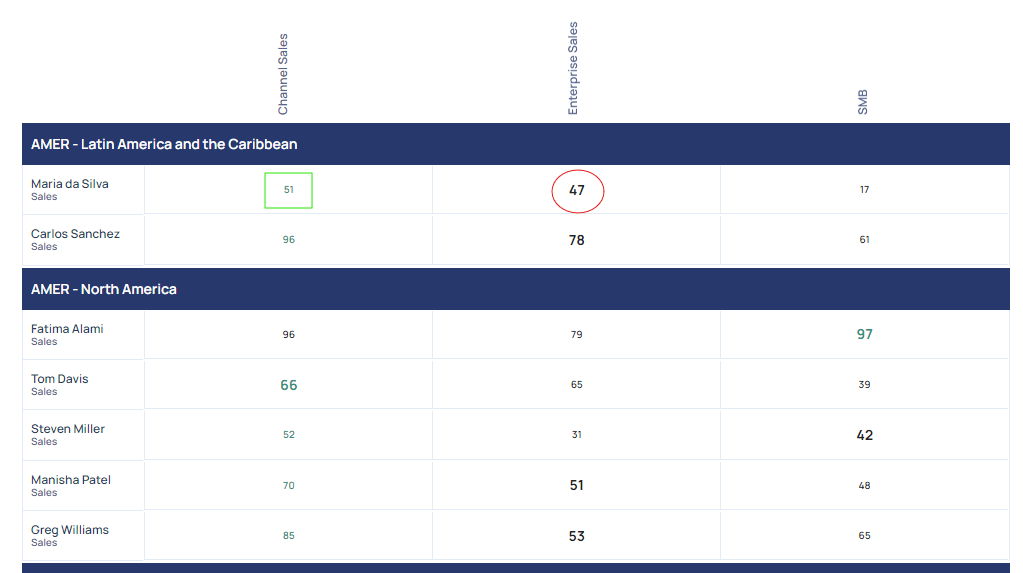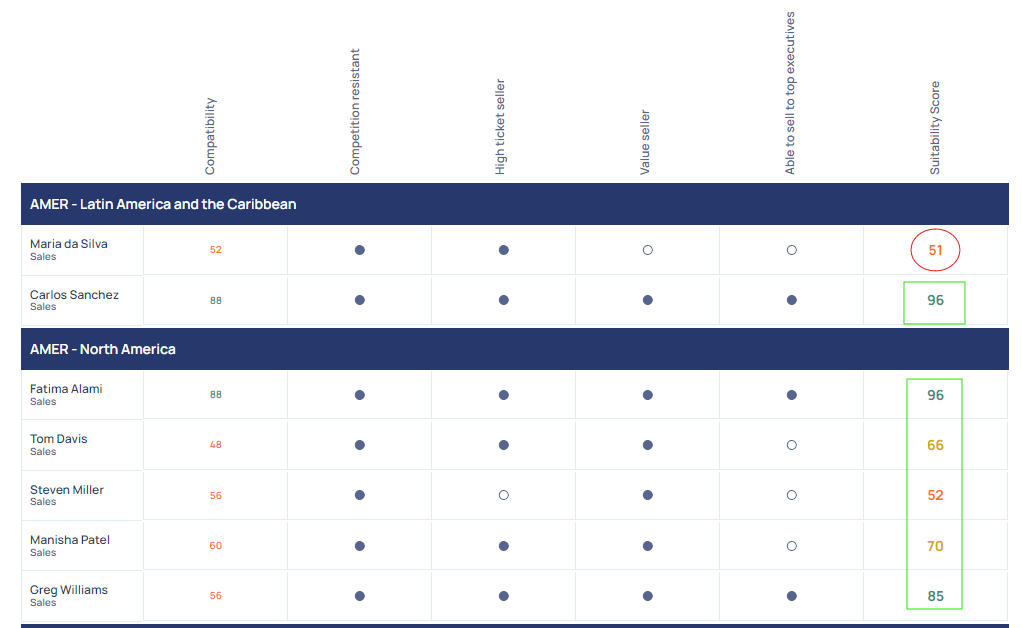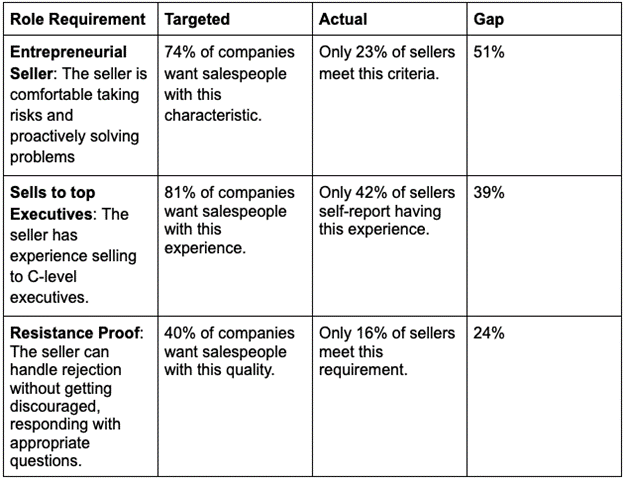
Role Misalignment: The Sneaky Problem That’s Sinking Your Sales Org
“DO I HAVE THE RIGHT PEOPLE IN THE RIGHT SEATS?”
Most CEOs we know ask themselves this question almost daily—regardless of how well their companies are doing.
Whether revenue is growing, flatlining, or worse, your people hold the greatest power over your company’s performance.
This is because CEOs know that their business’s momentum and trajectory hinge on getting the right people in the right seats. But all too often, you don’t know whether you’ve brought on the right person—and placed them in the right role—until you’re showing them the door.
There is perhaps no other function more reliant on accurate talent placement than sales. On quota-carrying sales teams, each seller is directly responsible for a proportion of the company’s profits. Unfortunately, sales is also one of the functions that experience the most misalignment, leading to high turnover.
Sales Role Misalignment by the Numbers
Our review of more than 100 in-depth sales team assessments found that 64% of companies have more than half of their salespeople in the wrong role.
Furthermore, of the 5,323 salespeople assessed, only 43% were in their best role.
Role misalignment is costly for resource-strapped businesses. Overall, 46% of the salespeople in our analysis were attaining quota. This is consistent with other research on B2B quota attainment. However, our research founds that only 34% of salespeople who are not in their best fit role are hitting quota. Contrast that to 58% of salespeople who are in their best fit role. Role fit contributes to a ~2x difference in quota attainment.
Furthermore, research from Deloitte found that the cost of replacing a bad hire is 150-200% of their salary. This includes the cost of recruiting and onboarding a new employee, lost productivity, lower team morale, operational errors, and training costs.
The worst part is that usually, it’s not the employee’s fault—they’ve simply been put in a role that is not well suited to their talent and skills and then left to muddle through.
Download our free role alignment hiring guide here.
SEIA: A Reliable Assessment of Fit
OMG’s proprietary Sales Effectiveness and Improvement Analysis (SEIA) provides a framework for objectively evaluating a team of sellers to determine whether each individual is a good fit for their current role—and whether they would be better suited for another selling role in the company. While the idea behind this assessment is simple—comparing the seller’s selling experience to the company’s specific requirements for that particular role—the logic and calculations behind it are nuanced and complex.
To give you a taste of how the assessment works, let’s walk through a couple of example reports. (Keep in mind that the SEIA measures alignment on a 100-point scale, with a score of 100 indicating a seller’s perfect alignment for the role.)
In the report below, you can see that according to the SEIA results, Maria de Silva currently is not in her “best” role at the company. She scored 47 for Enterprise Sales and 51 for Channel Sales—so at the very least, the company should move her into Channel Sales.
But looking at the next report, you can see that Maria’s score of 51 for Channel Sales still lags far behind all but two of her colleagues, whose scores range from 52 to 96. So ultimately, sales leadership should most likely replace Maria with someone who is a better fit for the company overall.
On the flip side, you can see in the first report that Carlos Sanchez scored 78 for his current role in Enterprise Sales, which isn’t bad. But, he also scored a whopping 96 for Channel Sales—meaning that despite his relative success in Enterprise Sales, he should most likely move into a Channel Sales role instead.
So, it’s not just about weeding out underperformers—it’s about giving high performers the opportunity to make an even bigger impact on the business.
Common Causes of Sales Role Misalignment
You might be wondering why people like Maria and Carlos end up in the wrong roles to begin with. Here at OMG, we tend to see two drivers of role misalignment in sales:
- Inadequate sales recruiting.
- Shifts in expectations for the role.
The chart below provides a few real-world examples of how this misalignment manifests.
It should come as no surprise that a sub-par approach to recruiting often results in the wrong person getting hired for an open role. This can happen when the company fails to:
- Accurately represent the job opening (perhaps because they omitted or glossed over key responsibilities and expectations).
- Use a skills-based assessment to evaluate all candidates’ suitability for the role.
- Uphold a consistent, structured interview process.
- Invest in a thorough, multi-month onboarding plan.
Sometimes a company hires the right seller for a role—but over time, the requirements for that role shift in a way that no longer suits the seller. For example, a company might transition from a BDR + AE model to an end-to-end selling model—or evolve from a two-call close to a complex solution sale process.
Keys to Preventing Sales Role Misalignment
When recruiting is the cause of role misalignment, it’s important for the company to audit its sales hiring process. Ideally, you would complete the following on an annual basis:
- Revisit all job descriptions to make sure they are still true to the actual demands of each role.
- Benchmark compensation to market expectations.
- Review the company’s hiring scorecard, structure, and interview questions.
To prevent misalignment as roles shift, it’s critical for the company’s sales leadership to hold a quarterly alignment and talent review of their sales managers—who are ultimately responsible for reinforcing day-to-day role requirements. This should also include reviews of each sales manager’s coaching and performance improvement plans for their individual reps.
The only thing worse than not having the right salespeople in the right roles is not realizing there’s a problem until it’s too late. If you’re not 100% confident that each member of your sales team is in a position that empowers them to use their individual talents and skills to the fullest, then I highly recommend deploying a tool like the Sales Effectiveness and Improvement Analysis in your organization.
Download our free role alignment hiring guide here.




